Wilmington University: Data Backup, Disaster Recovery and Planning
VerifiedAdded on 2020/04/15
|7
|1179
|143
Report
AI Summary
This report, focusing on data backup, disaster recovery, and business continuity, begins by highlighting the importance of data in organizations and the necessity of safeguarding it. It discusses data backup planning, emphasizing the assessment of potential threats and the development of effective backup plans, including off-site backups and data encryption. The report then delves into disaster recovery planning, stressing the importance of communication and testing to ensure successful data retrieval after data loss. It also covers business continuity planning, which involves managing business activities during data loss or other disasters. The report concludes by reiterating the need for organizations to implement comprehensive data protection strategies, including backup and recovery plans, to maintain business sustainability and ensure data security. References and links to external resources are also provided to support the findings.
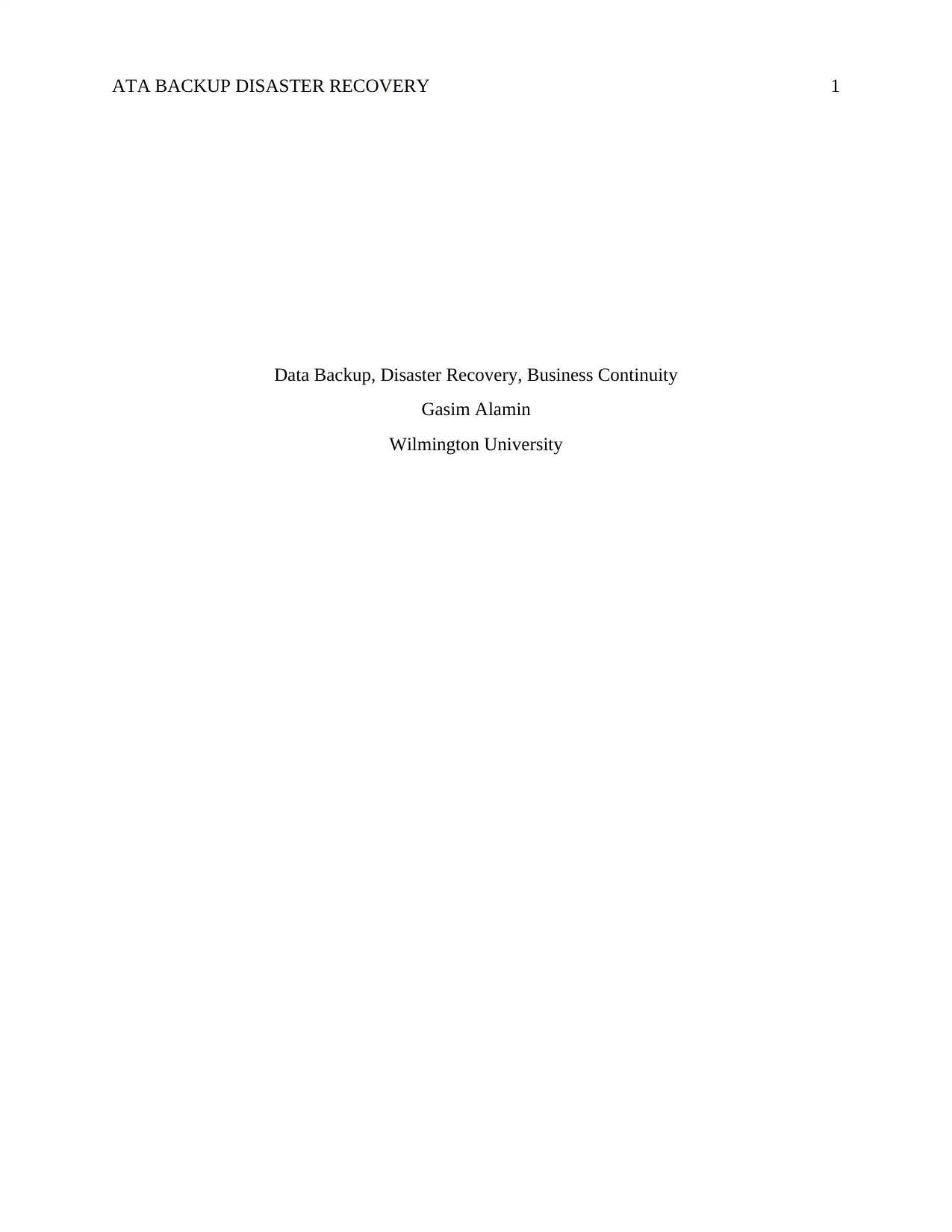
ATA BACKUP DISASTER RECOVERY 1
Data Backup, Disaster Recovery, Business Continuity
Gasim Alamin
Wilmington University
Data Backup, Disaster Recovery, Business Continuity
Gasim Alamin
Wilmington University
Paraphrase This Document
Need a fresh take? Get an instant paraphrase of this document with our AI Paraphraser
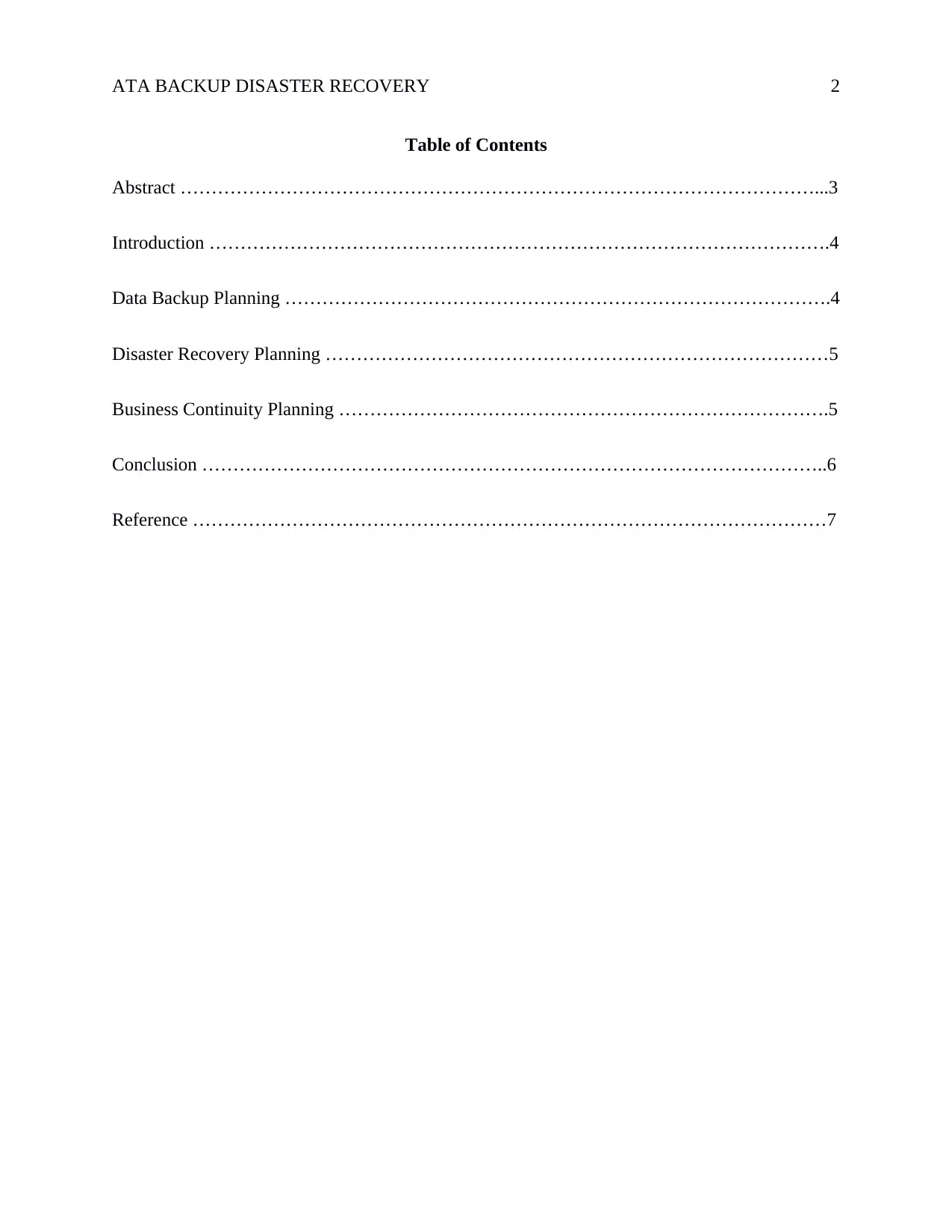
ATA BACKUP DISASTER RECOVERY 2
Table of Contents
Abstract …………………………………………………………………………………………...3
Introduction ……………………………………………………………………………………….4
Data Backup Planning …………………………………………………………………………….4
Disaster Recovery Planning ………………………………………………………………………5
Business Continuity Planning …………………………………………………………………….5
Conclusion ………………………………………………………………………………………..6
Reference …………………………………………………………………………………………7
Table of Contents
Abstract …………………………………………………………………………………………...3
Introduction ……………………………………………………………………………………….4
Data Backup Planning …………………………………………………………………………….4
Disaster Recovery Planning ………………………………………………………………………5
Business Continuity Planning …………………………………………………………………….5
Conclusion ………………………………………………………………………………………..6
Reference …………………………………………………………………………………………7
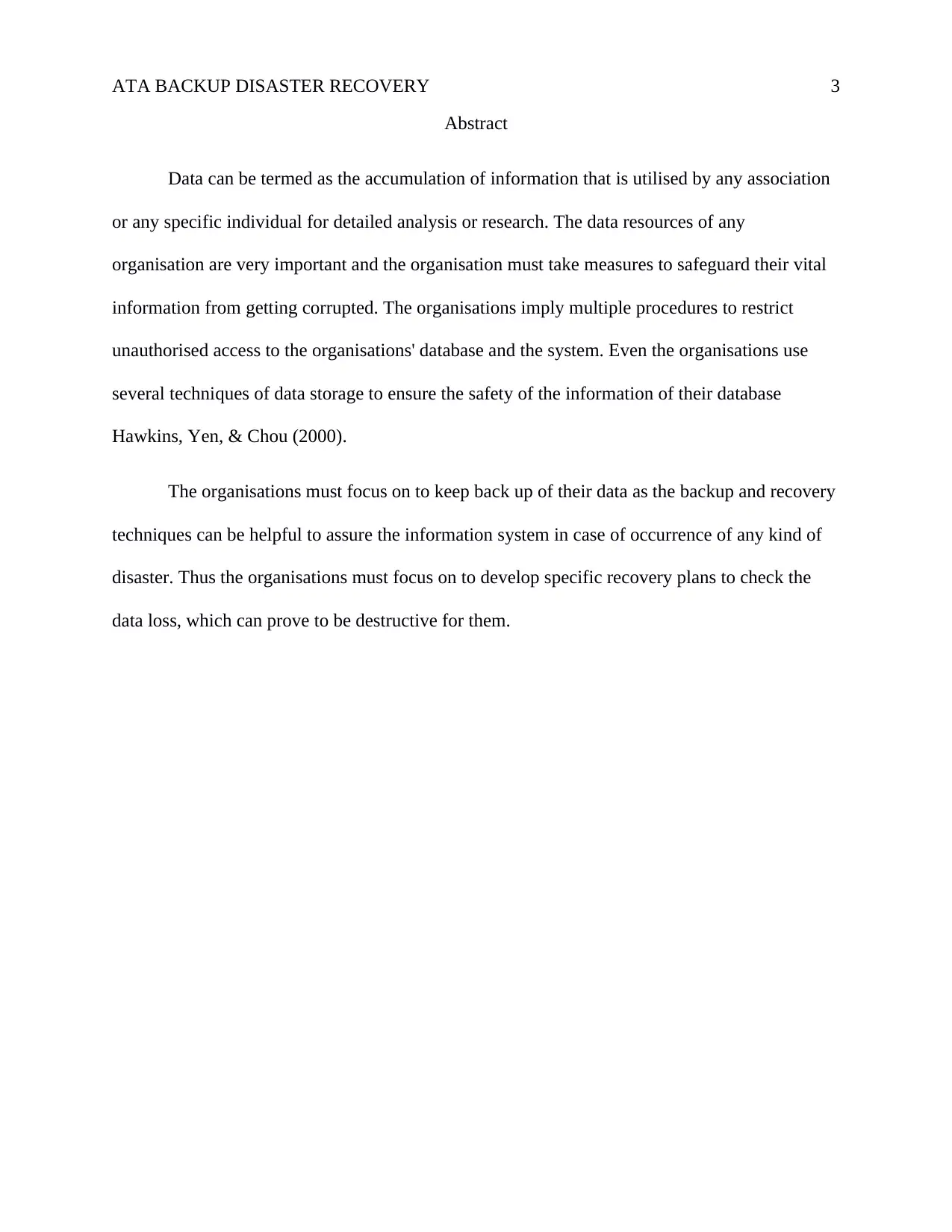
ATA BACKUP DISASTER RECOVERY 3
Abstract
Data can be termed as the accumulation of information that is utilised by any association
or any specific individual for detailed analysis or research. The data resources of any
organisation are very important and the organisation must take measures to safeguard their vital
information from getting corrupted. The organisations imply multiple procedures to restrict
unauthorised access to the organisations' database and the system. Even the organisations use
several techniques of data storage to ensure the safety of the information of their database
Hawkins, Yen, & Chou (2000).
The organisations must focus on to keep back up of their data as the backup and recovery
techniques can be helpful to assure the information system in case of occurrence of any kind of
disaster. Thus the organisations must focus on to develop specific recovery plans to check the
data loss, which can prove to be destructive for them.
Abstract
Data can be termed as the accumulation of information that is utilised by any association
or any specific individual for detailed analysis or research. The data resources of any
organisation are very important and the organisation must take measures to safeguard their vital
information from getting corrupted. The organisations imply multiple procedures to restrict
unauthorised access to the organisations' database and the system. Even the organisations use
several techniques of data storage to ensure the safety of the information of their database
Hawkins, Yen, & Chou (2000).
The organisations must focus on to keep back up of their data as the backup and recovery
techniques can be helpful to assure the information system in case of occurrence of any kind of
disaster. Thus the organisations must focus on to develop specific recovery plans to check the
data loss, which can prove to be destructive for them.
⊘ This is a preview!⊘
Do you want full access?
Subscribe today to unlock all pages.

Trusted by 1+ million students worldwide
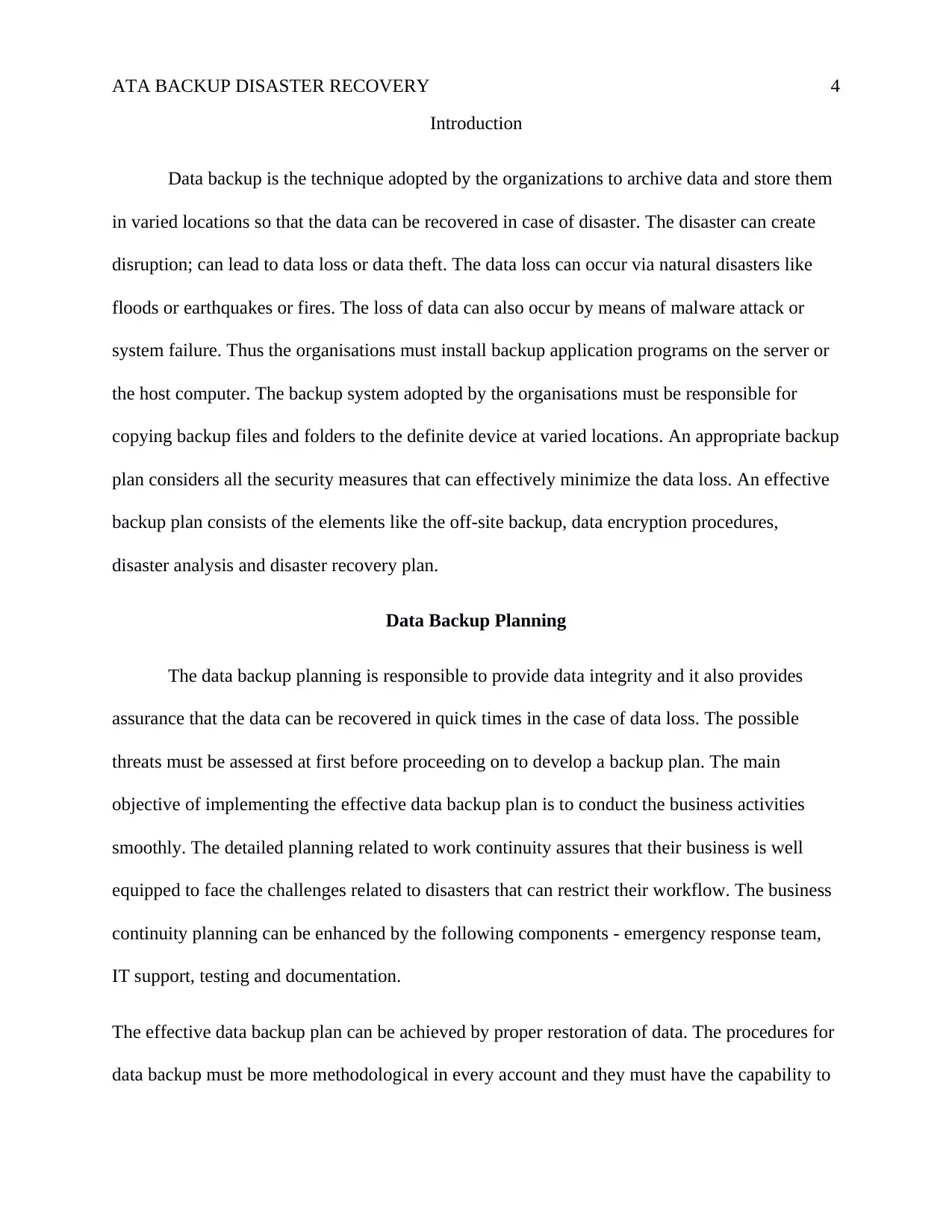
ATA BACKUP DISASTER RECOVERY 4
Introduction
Data backup is the technique adopted by the organizations to archive data and store them
in varied locations so that the data can be recovered in case of disaster. The disaster can create
disruption; can lead to data loss or data theft. The data loss can occur via natural disasters like
floods or earthquakes or fires. The loss of data can also occur by means of malware attack or
system failure. Thus the organisations must install backup application programs on the server or
the host computer. The backup system adopted by the organisations must be responsible for
copying backup files and folders to the definite device at varied locations. An appropriate backup
plan considers all the security measures that can effectively minimize the data loss. An effective
backup plan consists of the elements like the off-site backup, data encryption procedures,
disaster analysis and disaster recovery plan.
Data Backup Planning
The data backup planning is responsible to provide data integrity and it also provides
assurance that the data can be recovered in quick times in the case of data loss. The possible
threats must be assessed at first before proceeding on to develop a backup plan. The main
objective of implementing the effective data backup plan is to conduct the business activities
smoothly. The detailed planning related to work continuity assures that their business is well
equipped to face the challenges related to disasters that can restrict their workflow. The business
continuity planning can be enhanced by the following components - emergency response team,
IT support, testing and documentation.
The effective data backup plan can be achieved by proper restoration of data. The procedures for
data backup must be more methodological in every account and they must have the capability to
Introduction
Data backup is the technique adopted by the organizations to archive data and store them
in varied locations so that the data can be recovered in case of disaster. The disaster can create
disruption; can lead to data loss or data theft. The data loss can occur via natural disasters like
floods or earthquakes or fires. The loss of data can also occur by means of malware attack or
system failure. Thus the organisations must install backup application programs on the server or
the host computer. The backup system adopted by the organisations must be responsible for
copying backup files and folders to the definite device at varied locations. An appropriate backup
plan considers all the security measures that can effectively minimize the data loss. An effective
backup plan consists of the elements like the off-site backup, data encryption procedures,
disaster analysis and disaster recovery plan.
Data Backup Planning
The data backup planning is responsible to provide data integrity and it also provides
assurance that the data can be recovered in quick times in the case of data loss. The possible
threats must be assessed at first before proceeding on to develop a backup plan. The main
objective of implementing the effective data backup plan is to conduct the business activities
smoothly. The detailed planning related to work continuity assures that their business is well
equipped to face the challenges related to disasters that can restrict their workflow. The business
continuity planning can be enhanced by the following components - emergency response team,
IT support, testing and documentation.
The effective data backup plan can be achieved by proper restoration of data. The procedures for
data backup must be more methodological in every account and they must have the capability to
Paraphrase This Document
Need a fresh take? Get an instant paraphrase of this document with our AI Paraphraser
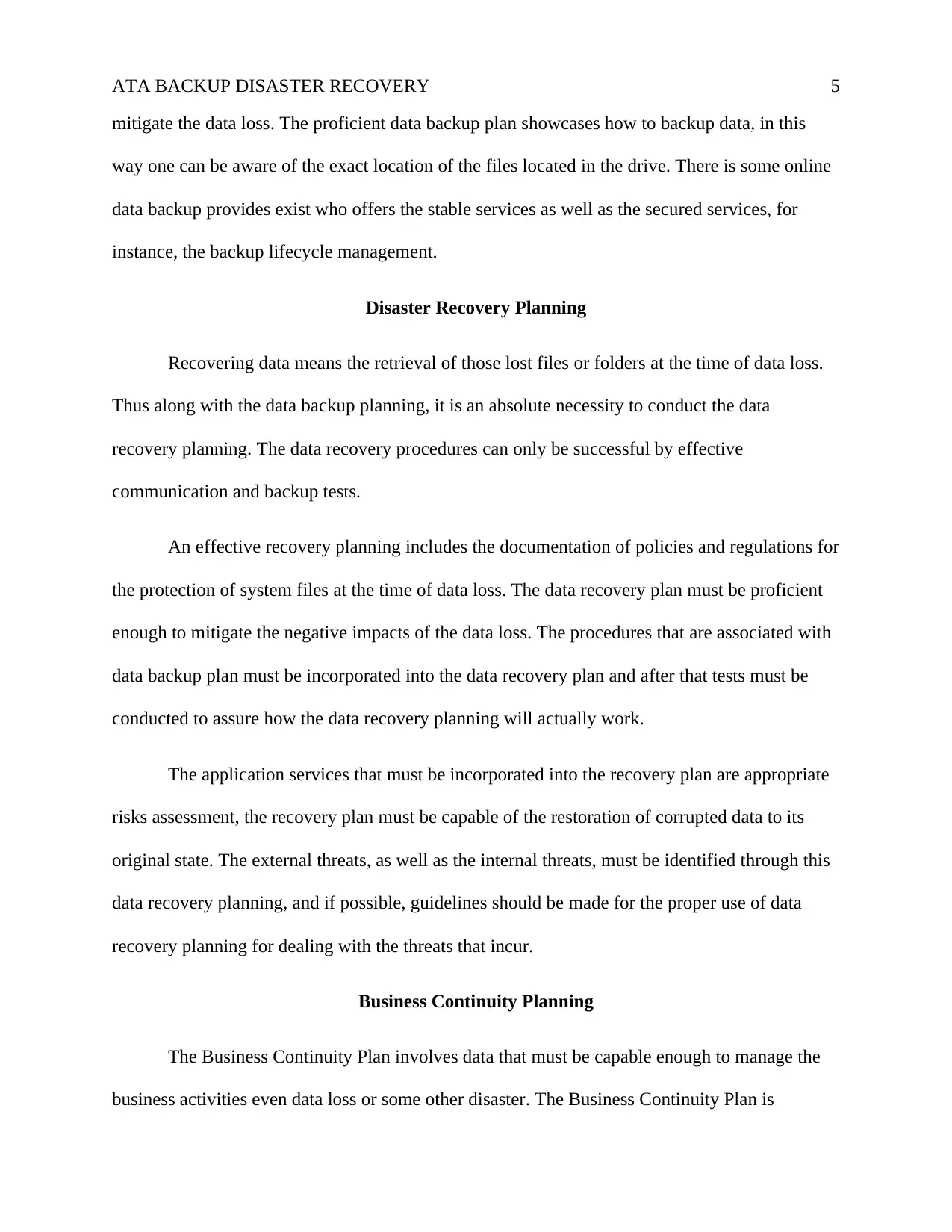
ATA BACKUP DISASTER RECOVERY 5
mitigate the data loss. The proficient data backup plan showcases how to backup data, in this
way one can be aware of the exact location of the files located in the drive. There is some online
data backup provides exist who offers the stable services as well as the secured services, for
instance, the backup lifecycle management.
Disaster Recovery Planning
Recovering data means the retrieval of those lost files or folders at the time of data loss.
Thus along with the data backup planning, it is an absolute necessity to conduct the data
recovery planning. The data recovery procedures can only be successful by effective
communication and backup tests.
An effective recovery planning includes the documentation of policies and regulations for
the protection of system files at the time of data loss. The data recovery plan must be proficient
enough to mitigate the negative impacts of the data loss. The procedures that are associated with
data backup plan must be incorporated into the data recovery plan and after that tests must be
conducted to assure how the data recovery planning will actually work.
The application services that must be incorporated into the recovery plan are appropriate
risks assessment, the recovery plan must be capable of the restoration of corrupted data to its
original state. The external threats, as well as the internal threats, must be identified through this
data recovery planning, and if possible, guidelines should be made for the proper use of data
recovery planning for dealing with the threats that incur.
Business Continuity Planning
The Business Continuity Plan involves data that must be capable enough to manage the
business activities even data loss or some other disaster. The Business Continuity Plan is
mitigate the data loss. The proficient data backup plan showcases how to backup data, in this
way one can be aware of the exact location of the files located in the drive. There is some online
data backup provides exist who offers the stable services as well as the secured services, for
instance, the backup lifecycle management.
Disaster Recovery Planning
Recovering data means the retrieval of those lost files or folders at the time of data loss.
Thus along with the data backup planning, it is an absolute necessity to conduct the data
recovery planning. The data recovery procedures can only be successful by effective
communication and backup tests.
An effective recovery planning includes the documentation of policies and regulations for
the protection of system files at the time of data loss. The data recovery plan must be proficient
enough to mitigate the negative impacts of the data loss. The procedures that are associated with
data backup plan must be incorporated into the data recovery plan and after that tests must be
conducted to assure how the data recovery planning will actually work.
The application services that must be incorporated into the recovery plan are appropriate
risks assessment, the recovery plan must be capable of the restoration of corrupted data to its
original state. The external threats, as well as the internal threats, must be identified through this
data recovery planning, and if possible, guidelines should be made for the proper use of data
recovery planning for dealing with the threats that incur.
Business Continuity Planning
The Business Continuity Plan involves data that must be capable enough to manage the
business activities even data loss or some other disaster. The Business Continuity Plan is
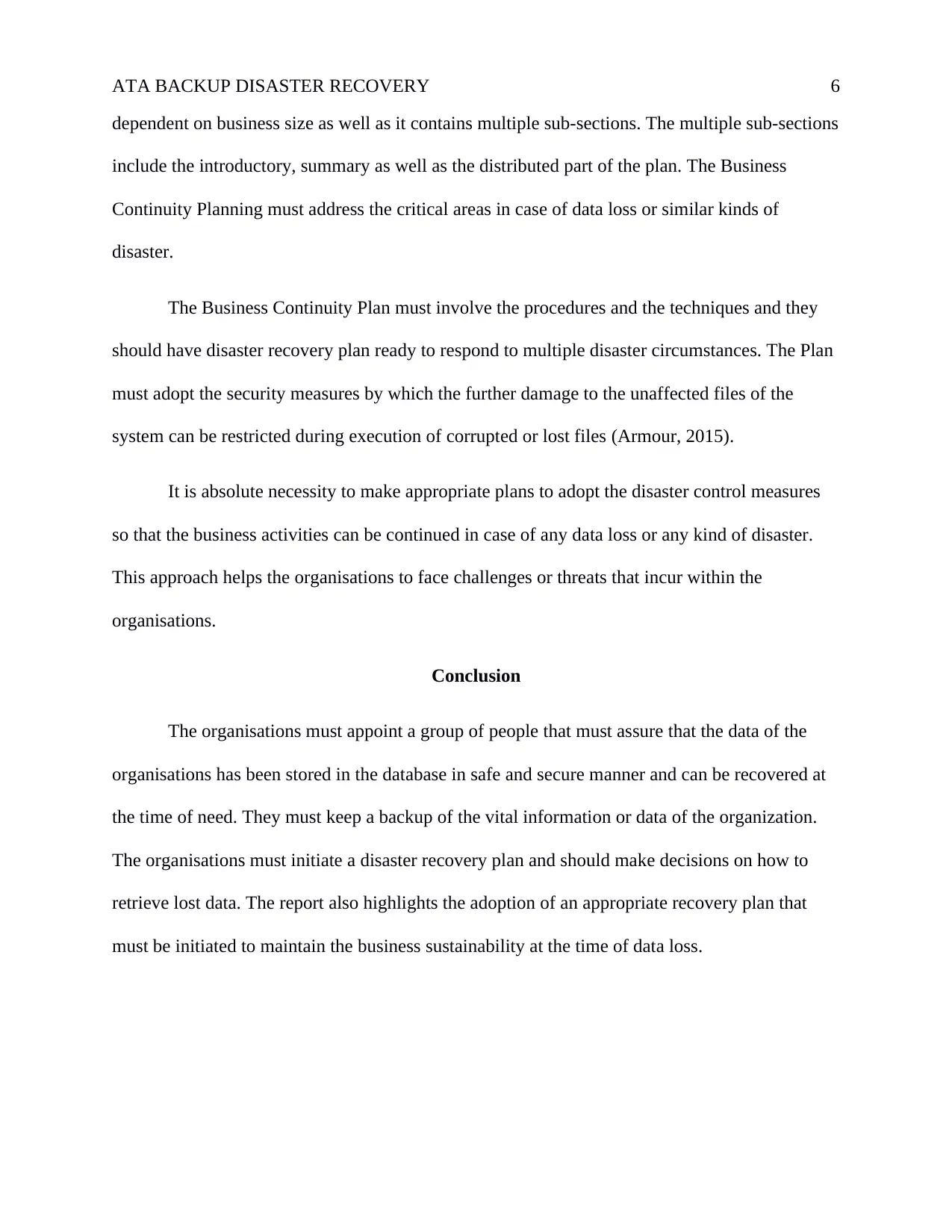
ATA BACKUP DISASTER RECOVERY 6
dependent on business size as well as it contains multiple sub-sections. The multiple sub-sections
include the introductory, summary as well as the distributed part of the plan. The Business
Continuity Planning must address the critical areas in case of data loss or similar kinds of
disaster.
The Business Continuity Plan must involve the procedures and the techniques and they
should have disaster recovery plan ready to respond to multiple disaster circumstances. The Plan
must adopt the security measures by which the further damage to the unaffected files of the
system can be restricted during execution of corrupted or lost files (Armour, 2015).
It is absolute necessity to make appropriate plans to adopt the disaster control measures
so that the business activities can be continued in case of any data loss or any kind of disaster.
This approach helps the organisations to face challenges or threats that incur within the
organisations.
Conclusion
The organisations must appoint a group of people that must assure that the data of the
organisations has been stored in the database in safe and secure manner and can be recovered at
the time of need. They must keep a backup of the vital information or data of the organization.
The organisations must initiate a disaster recovery plan and should make decisions on how to
retrieve lost data. The report also highlights the adoption of an appropriate recovery plan that
must be initiated to maintain the business sustainability at the time of data loss.
dependent on business size as well as it contains multiple sub-sections. The multiple sub-sections
include the introductory, summary as well as the distributed part of the plan. The Business
Continuity Planning must address the critical areas in case of data loss or similar kinds of
disaster.
The Business Continuity Plan must involve the procedures and the techniques and they
should have disaster recovery plan ready to respond to multiple disaster circumstances. The Plan
must adopt the security measures by which the further damage to the unaffected files of the
system can be restricted during execution of corrupted or lost files (Armour, 2015).
It is absolute necessity to make appropriate plans to adopt the disaster control measures
so that the business activities can be continued in case of any data loss or any kind of disaster.
This approach helps the organisations to face challenges or threats that incur within the
organisations.
Conclusion
The organisations must appoint a group of people that must assure that the data of the
organisations has been stored in the database in safe and secure manner and can be recovered at
the time of need. They must keep a backup of the vital information or data of the organization.
The organisations must initiate a disaster recovery plan and should make decisions on how to
retrieve lost data. The report also highlights the adoption of an appropriate recovery plan that
must be initiated to maintain the business sustainability at the time of data loss.
⊘ This is a preview!⊘
Do you want full access?
Subscribe today to unlock all pages.

Trusted by 1+ million students worldwide
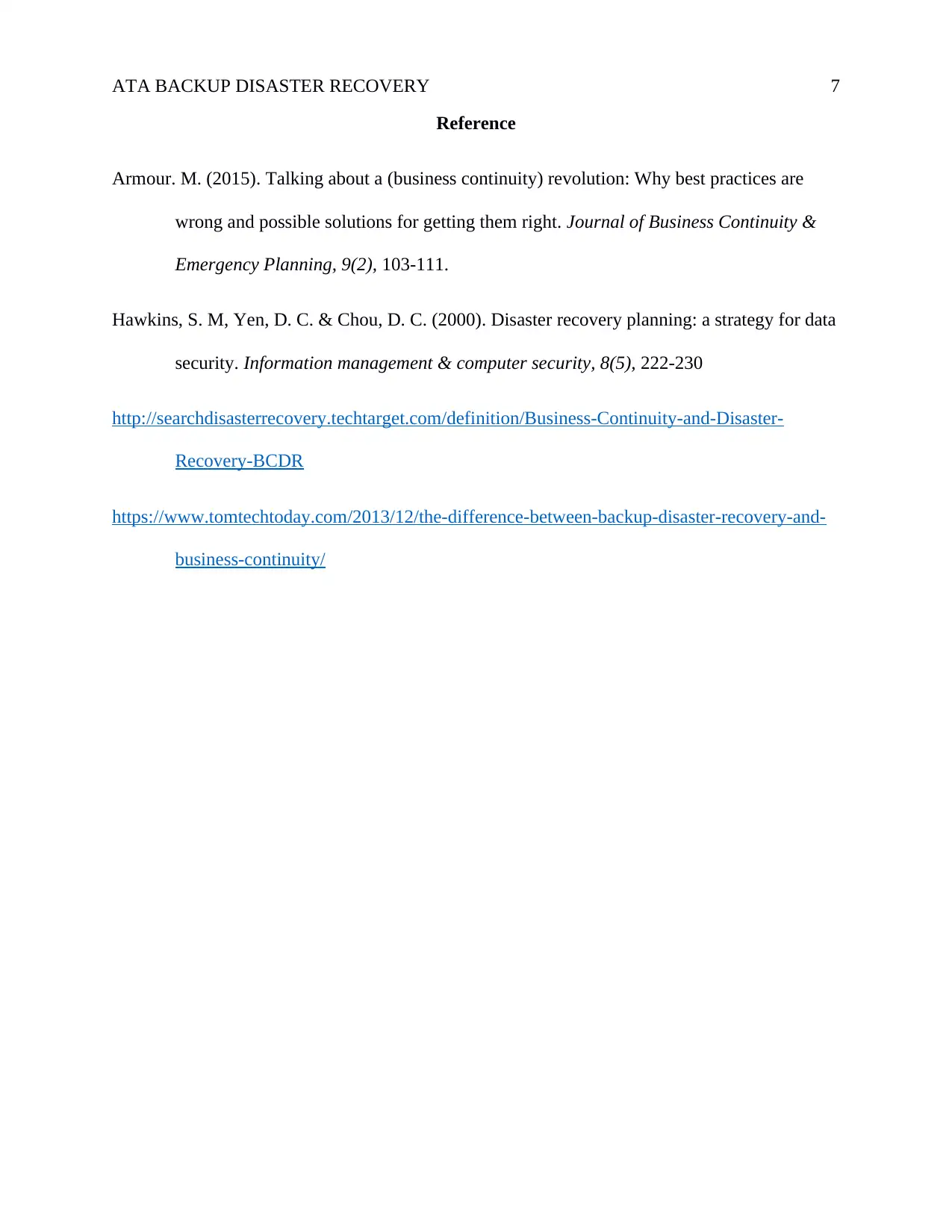
ATA BACKUP DISASTER RECOVERY 7
Reference
Armour. M. (2015). Talking about a (business continuity) revolution: Why best practices are
wrong and possible solutions for getting them right. Journal of Business Continuity &
Emergency Planning, 9(2), 103-111.
Hawkins, S. M, Yen, D. C. & Chou, D. C. (2000). Disaster recovery planning: a strategy for data
security. Information management & computer security, 8(5), 222-230
http://searchdisasterrecovery.techtarget.com/definition/Business-Continuity-and-Disaster-
Recovery-BCDR
https://www.tomtechtoday.com/2013/12/the-difference-between-backup-disaster-recovery-and-
business-continuity/
Reference
Armour. M. (2015). Talking about a (business continuity) revolution: Why best practices are
wrong and possible solutions for getting them right. Journal of Business Continuity &
Emergency Planning, 9(2), 103-111.
Hawkins, S. M, Yen, D. C. & Chou, D. C. (2000). Disaster recovery planning: a strategy for data
security. Information management & computer security, 8(5), 222-230
http://searchdisasterrecovery.techtarget.com/definition/Business-Continuity-and-Disaster-
Recovery-BCDR
https://www.tomtechtoday.com/2013/12/the-difference-between-backup-disaster-recovery-and-
business-continuity/
1 out of 7
Related Documents
Your All-in-One AI-Powered Toolkit for Academic Success.
+13062052269
info@desklib.com
Available 24*7 on WhatsApp / Email
![[object Object]](/_next/static/media/star-bottom.7253800d.svg)
Unlock your academic potential
Copyright © 2020–2025 A2Z Services. All Rights Reserved. Developed and managed by ZUCOL.




